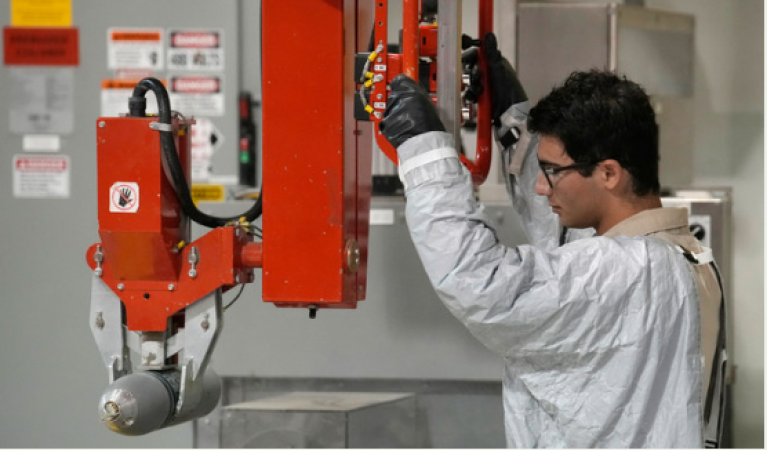
Kentucky: An important turning point in the history of warfare going back to World War I is about to occur at a vast military installation in the middle of the lush, rolling hills of eastern Kentucky.
The last of the United States' declared chemical weapons, rockets containing GB nerve agent, are about to be destroyed by workers at the Blue Grass Army Depot, capping a decades-long effort to destroy a stockpile that by the end of the Cold War weighed more than 30,000 tonnes.
For Richmond, Kentucky, and Pueblo, Colorado, where an Army depot destroyed the last of its chemical agents last month, the destruction of the weapons marks a significant turning point. Additionally, it marks a turning point for global efforts at arms control.
Also Read: Report: France will permit police to monitor suspects' phone activity
In accordance with the international Chemical Weapons Convention, which went into effect in 1997 and to which 193 nations have acceded, the United States has until September 30 to destroy all of its remaining chemical weapons. The last of 51,000 M55 rockets with GB nerve agent, a deadly toxin also known as sarin, that have been kept at the depot since the 1940s, are being destroyed in Kentucky.
According to military experts, by destroying the munitions, the U.S. is formally emphasising that these kinds of weapons are no longer acceptable on the battlefield and sending a message to the few nations that haven't ratified the agreement.
"How we're finishing the mission is one accomplishment of which we're incredibly proud. Kim Jackson, manager of the Pueblo Chemical Agent-Destruction Pilot Plant, declared, "We're finishing it for good for the United States of America.
In World War I, chemical weapons were first employed in warfare, and it is estimated that at least 100,000 people died as a result of their use. Even after the Geneva Convention forbade their use, nations kept the weapons in storage until the treaty requiring their destruction.
Also Read: Due to the "India appoints PM" controversy, the opposition demands Prachanda's resignation
Workers at the Army Pueblo Chemical Depot in southern Colorado began destroying the weapons in 2016 and finished the task of neutralising the entire stockpile of 2,600 tonnes of mustard blister agent on June 22. About 8.5% of the nation's initial 30,610 tonnes of agent chemical weapons stockpile was made up of projectiles and mortars.
Since the 1950s, a large area of farmland east of Pueblo has been home to a collection of concrete and earthen bunkers that have been used to store nearly 800,000 chemical weapons containing mustard agent.
Civic leaders in Colorado and Kentucky acknowledge that a worry was always present, but that it has been allayed by the destruction of the weapons.
Pueblo Mayor Nick Gradisar stated that "those (weapons) sitting there were not a threat." Nevertheless, he continued, "you always wondered what might happen with them."
The community surrounding Kentucky's Blue Grass Army Depot protested the Army's initial plan to burn the plant's 520 tonnes of chemical weapons in the 1980s, sparking a long-running conflict over how to dispose of them. They were successful in stopping the construction of the incineration facility, and with the assistance of lawmakers, they persuaded the Army to propose alternatives to burning the weapons.
Residents were worried about potential toxic pollution from burning the deadly chemical agents, according to Craig Williams, who later joined forces with political leadership and the military. Williams rose to prominence as the community's chief opponent.
Williams noted that the military burned weapons at other, more remote locations, such as Johnston Atoll in the Pacific Ocean or at a chemical depot in the middle of the Utah desert, to eliminate the majority of its stockpile. However, the Kentucky location was close to Richmond and only a few hundred miles from Lexington, the second-largest city in the state.
A mile away from the (planned) smokestack, there was a middle school with more than 600 students, according to Williams.
Since the 1940s, the Kentucky storage facility has kept mustard agent, VX, and sarin nerve agents, much of it concealed inside rockets and other projectiles. The state's disposal facility was finished in 2015, and it started disarming arms in 2019. The deadly agents are diluted using a method known as neutralisation so they can be safely disposed of.
Also Read: Mother kept teenager for eight years as a "sex slave."
However, the project has been beneficial for both communities, and in light of the impending loss of thousands of jobs, both are highlighting the availability of highly skilled labourers as a benefit for businesses looking to set up shop in their areas.